
Advocacy
What is the creative economy?
The term creative economy was popularized by John Howkins in Creative Economy: How People Make Money From Ideas. Howkins called it a new way of thinking and doing that revitalizes manufacturing, services, retailing, and entertainment industries with a focus on individual talent or skill, and art, culture, design, and innovation. Other definitions:
“The creative economy is a powerful engine of growth and community vitality. Together, artists, cultural nonprofits, and creative businesses produce and distribute cultural goods and services that generate jobs, revenue, and quality of life. A thriving cultural sector leads to thriving communities.” - New England Foundation for the Arts
“The creative economy involves both individuals and entities who engage in activities that add value to society in one or more ways through the provision of goods and/or services that are inextricably linked to human creativity manifesting itself in one or more dimensions throughout the process of ideation, creation, production, distribution, and use.” - Creative Economy Coalition – America’s Creative Economy report
“The creative industries enrich people’s lives; they shape the distinctive features of different societies as well as providing the means by which cultures and communities communicate with each other.” - British Council
Why advocate for the creative economy?
Creativity, innovation, imagination, and entrepreneurship are the attributes needed to move our economy, educational systems, and civic infrastructure forward as well as to enliven and diversify our communities.
Don’t assume decision-makers already know about and support investment in the creative economy. If you are a passionate, knowledgeable expert on the subject, who better to express the public value of creativity locally and globally?
If you’ve received funding from a public agency on any level, OR if you haven’t received funding but you think that you should have, tell elected representatives that investment in creativity is the key to economic, educational and civic success.
The more voices the better - that’s the #1 rule of advocacy.
Your involvement and leadership will help get others involved. You cannot expect others to be tenacious and committed if you are not tenacious and committed.

